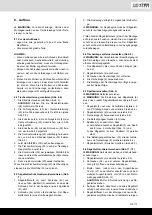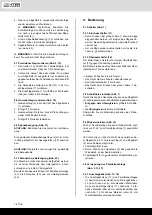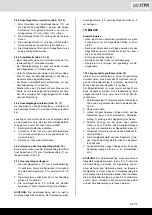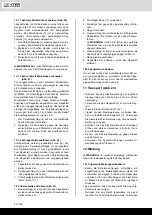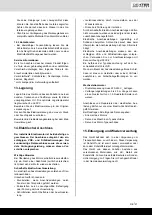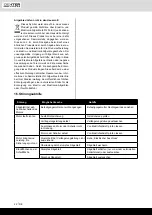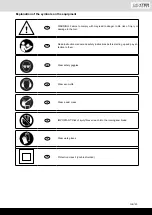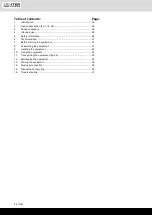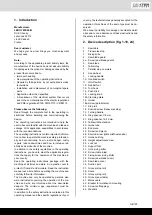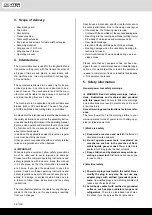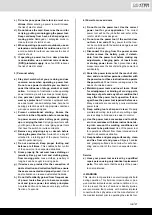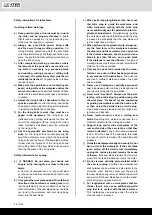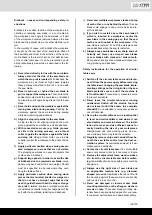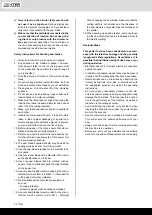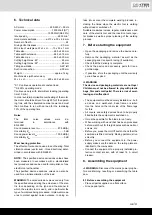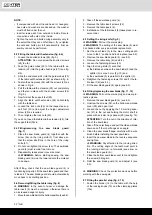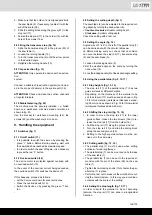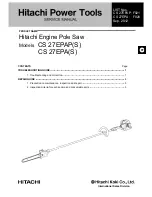
GB | 29
i) Never saw multiple workpieces stacked on top
of each other, or one behind the other.
The saw
blade could engage in one or more parts and re-
sult in kickback.
j) If you wish to restart a saw, the saw blade of
which is inserted in a workpiece, centre the
saw blade in the sawing gap so that the saw
teeth are not hooked in the workpiece.
If the
saw blade is jammed, it can lift the workpiece and
cause kickback when the saw is restarted.
k) Always keep saw blades clean, sharp and suf-
ficiently set. Never use warped saw blades
or saw blades with cracked or broken teeth.
Sharp and correctly set saw blades minimise jam-
ming, blocking and kickback.
Safety instructions for the operation of circular
table saws
a) Switch off the circular table saw and discon-
nect it from the power supply before removing
the table insert, changing the saw blade, imple-
menting settings on the riving knife or the saw
blade protective cover, and if the machine is
left unattended.
Precautionary measures serve
to prevent accidents.
b) Never leave the circular table saw running
unattended. Switch off the electric tool and
do not leave it until it has come to a complete
standstill.
An unattended running saw poses an
uncontrolled risk.
c) Set up the circular table saw in a location that
is level and well ventilated, and where it can
stand safely and remain balanced. The instal-
lation site must provide sufficient space for
easily handling the size of your workpieces.
Disorganised and unlit working areas, and un-
even, slippery floors may lead to accidents.
d) Regularly remove chips and sawdust from be-
neath the saw table and/or from the dust ex-
traction system.
Accumulated sawdust is flam
-
mable and can self-ignite.
e) Secure the circular table saw.
If a circular table
saw is not secured correctly, it can move or topple.
f) Remove the adjustment tools, wood residues,
etc. from the circular table saw before switch-
ing it on.
Deflections and possible jams could be
dangerous.
g) Always use the right size of saw blade and
an appropriate location hole (e.g. diamond-
shaped or round).
Saw blades that do not fit with
the mounting parts of the saw will run out-of-centre
and result in a loss of control.
h) Never use damaged or incorrect saw blade
mounting materials, such as flanges, washers,
screws or nuts.
These saw blade mounting ma-
terials have been specially designed for your saw,
for optimum performance and operational safety.
Kickback - causes and corresponding safety in-
structions
Kickback is a sudden reaction of the workpiece to a
catching or jamming saw blade, or a cut created in
the workpiece at an angle to the saw blade, or if part
of the workpiece becomes jammed between the saw
blade and the parallel stop, or another stationary ob-
ject.
In the majority of cases, with kickback the workpiece
is caught by the rear part of the saw blade, lifted off
the saw table and thrust in the direction of the opera-
tor. Kickback is the result of incorrect or deficient use
of the circular table saw. It can be prevented by suit-
able precautionary measures, as described in the fol-
lowing.
a) Never stand directly in line with the saw blade.
Always stand at the side of the saw blade on
which the stop rail is located.
With kickback, the
workpiece may be thrust at high speed towards
those persons who stand in front of, or in line with
the saw blade.
b) Never reach over or behind the saw blade to
pull or support the workpiece.
This can result in
accidental contact with the saw blade, or kickback
can lead to your fingers being drawn into the saw
blade.
c) Never hold and push the workpiece against the
turning saw blade during sawing.
Pushing the
workpiece against the saw blade during sawing
will lead to jamming and kickback.
d) Align the stop rail parallel to the saw blade.
A stop rail that is not aligned will push the work-
piece against the saw blade and create kickback.
e) With concealed saw cuts (e.g. folds, grooves
or slits in the turning process), use a thrust
collar to guide the workpiece against the table
and stop rail.
Using a thrust collar, you are able
to better control the workpiece in the event of kick-
back.
f) Apply particular caution when sawing assem-
bled workpieces in areas that are not visible.
The plunging saw blade can saw into objects that
could cause a kickback.
g) Support large panels, in order to avoid the risk
of kickback due to a jammed saw blade.
Large
panels may bend under their own weight. Panels
must be supported in all areas where they over-
hang the table surface.
h) Apply particular caution when sawing work-
pieces that are twisted, knotted or warped, or
that do not have a straight edge that can be
used to guide them with a mitre stop or along a
stop rail.
A twisted, knotted or warped workpiece
is unstable and results in incorrect alignment of the
kerf with the saw blade, jamming and kickback.
Содержание 3901309953
Страница 2: ...2 ...
Страница 4: ...4 10 6 6 7 9 8 8 14 11 4a 12 14 13 24 32 34 20 21 33 25 23 4 35 20 36 3 6 3 31 max 5mm ...
Страница 5: ...5 16 18 14 19 20 15 17 21 45 8 17 16a 37 9 16 17 16 17 18 19 40 39 16a 38 38 16a 17 ...
Страница 6: ...6 22 24 23 41 25 42 43 43 42 44 44 ...
Страница 70: ...70 ...
Страница 72: ...72 ...
Страница 76: ...LEROY MERLIN RUE Chanzy Lezennes 59712 LILLE Cedex 9 France ...



